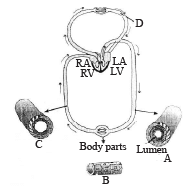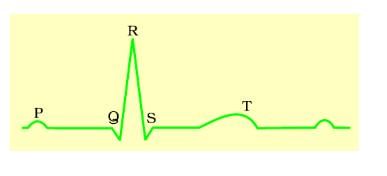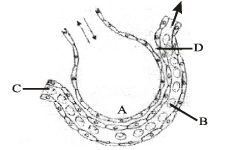31 Years NEET Previous Year Questions: Body Fluids & Circulation - 1 - NEET MCQ
30 Questions MCQ Test Biology 31 Years NEET Chapterwise Solved Papers - 31 Years NEET Previous Year Questions: Body Fluids & Circulation - 1
Which enzyme is responsible for the conversion of inactive fibrinogens to fibrins? [2021]
The QRS complex in a standard ECG represents : [2020]
| 1 Crore+ students have signed up on EduRev. Have you? Download the App |
What would be the heart rate of a person if the cardiac output is 5 L, blood volume in the ventricles at the end of diastole is 100 mL and at the end of the ventricular systole is 50 mL? [2019]
Figure shows blood circulation in humans with labels A to D. Select the option which gives correct identification of label and functions of the part: [NEET Kar. 2013]

Which one of the following blood cells is involved in antibody production.
The diagram given here is the standard ECG of a normal person, the P-wave represents the : [NEET 2013]

Which one of the following human organs is often called the graveyard of RBCs?[2011M]
Bulk of carbon dioxide (CO2) released from body tissues into the blood is present as [2011M]
Given below is the ECG of a normal human. Which one of its components in human is correctly interpreted below

Which one of the following statements is correct regarding blood pressure ? [2011]
Arteries are best defined as the vessels which : [2011]
Which one of the following plasma proteins is involved in the coagulation of blood ? [2011]
‘Bundle of His’ is a part of which one of the following organs in humans? [2011]
The figure given below shows a small part of human lung where exchange of gases takes place. In which one of the options given below, the one part A, B, C or D is correctly identified along with its function? [2011]

Options :
What is true about RBCs in humans? [2010]
If due to some injury the chordae tendinae of the tricuspid valve of the human heart is partially non - functional, what will be the immediate effect? [2010]
ABO blood groups in humans are controlled by the gene I. It has three alleles – IA IB and i. Since there are three different alleles, six different genotypes are possible. How many phenotypes can occur? [2010]
Globulins contained in human blood plasma are primarily involved in : [2009]
In a standard ECG which one of the following alphabets is the correct representation of the respective activity of the human heart?
There is no DNA in: [2009]
Compared to blood our lymph has: [2009]
The most popularly known blood grouping is the ABO grouping. It is named ABO and not ABC, because “O” in it refers to having: [2009]
In humans, blood passes from the post caval to the diastolic right atrium of heart due to. [2008]
The most active phagocytic white blood cells are: [2008]
Which type of white blood cells are concerned with the release of histamine and the natural anti- coagulant heparin? [2008]
What is true about Nereis, scorpion, cockroach and silver fish ? [2007]
A drop of each of the following, is placed separately on four slides. Which of them will not coagulate? [2007]
Which one of the following has an open circulatory system ? [2006]
The majority of carbon dioxide produced by our body cells is transported to the lungs [2006]
Examination of blood of a person suspected of having anemia, shows large, immature, nucleated erythrocytes without haemoglobin. Supple-menting his diet with which of the following, is likely to alleviate his symptoms? [2006]
|
33 docs|83 tests
|
|
33 docs|83 tests
|




















